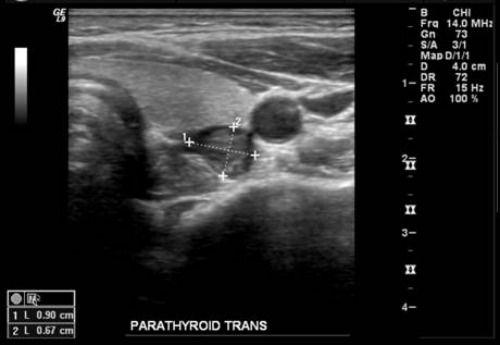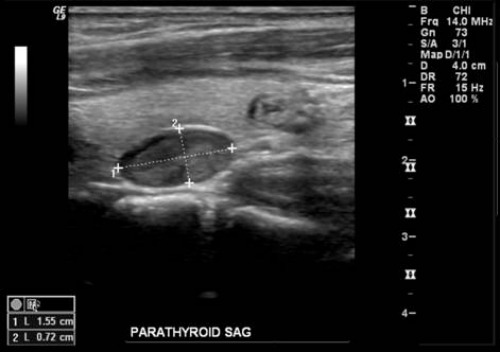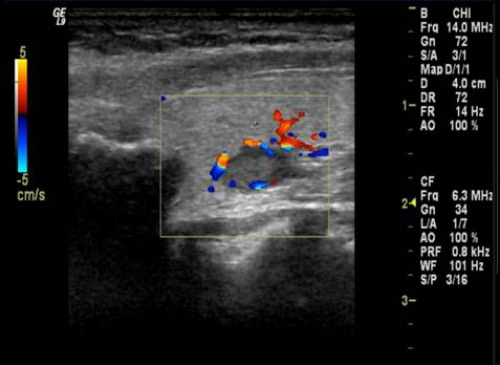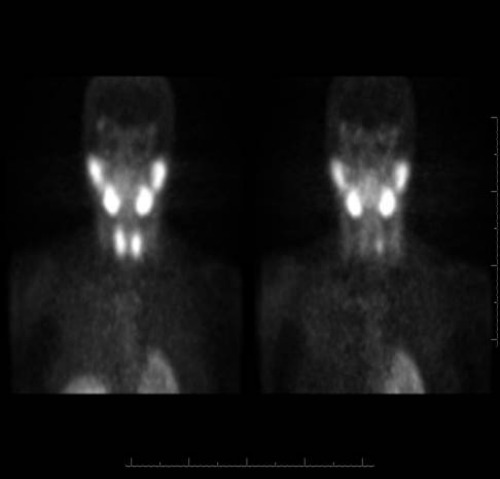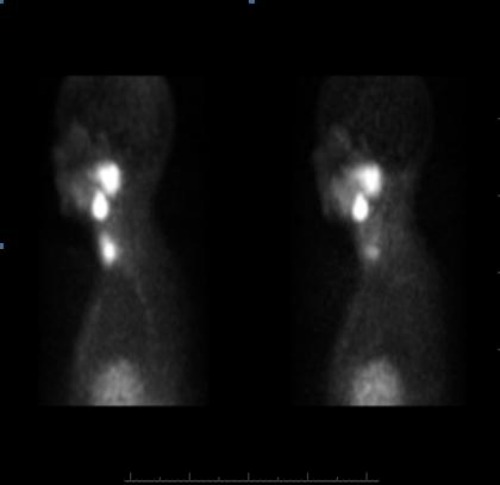Clinical history:
46 year old woman with documented primary hyperparathyroidism. She has complaints of joint pain and fatigue. A DEXA scan confirmed advanced osteoporosis. Ultrasound was requested prior to parathyroidectomy.
Laboratory:
Serum calcium of 10.2 mg/dL
PTH of 124 pg/mL
Results:
These Sonographic and Tc99m Sestamibi images were consistent with findings of a descended superior parathyroid adenoma which was proven at exploration.
Questions:
Which of the following are sonographic characteristics of parathyroid adenomas? (More than one may be correct)
- Solid
- Hypoechoic
- Oval Shape
- Hypervascular (Variable)
- Posterior to Thyroid
- Medial to Carotid
Where are common locations of ectopic parathyroid adenomas? (More than one may be correct)
- Low Neck
- Mediastinum
- Retrotracheal/Retroesophageal
- Carotid Sheath
- Intrathyroid
True or false: Normal parathyroid glands are usually seen on sonography?
Answers:
Which of the following are sonographic characteristics of parathyroid adenomas? (More than one may be correct)
All of the above are correct. Please see discussion for details.
Where are common locations of ectopic parathyroid adenomas? (More than one may be correct)
All of the above are correct. Please see discussion for details.
True or false: Normal parathyroid glands are usually seen on sonography?
False. Please see discussion for details.
Discussion:
Most individuals have 4 parathyroid glands: 2 superior and 2 inferior. The superior glands are usually posterior to the upper or mid pole of the thyroid gland. The inferior glands have a variable location but are usually inferoposterior to the thyroid. Normal parathyroid glands are not reliably seen on sonography and measure approximately 1x3x5 mm.
Primary hyperparathyroidism is a common endocrine disorder which affects individuals usually in the 40-60 years of age range. Females are four times more likely to suffer from the disorder which is usually (85%) the result of a single parathyroid adenoma. Laboratory values show an increased serum PTH and calcium. Advanced cases can present with renal calculi and osteopenia.
On sonography, parathyroid adenomas appear solid, hypoechoic, and oval. They have variable hypervascularity and are usually located posterior to the thyroid and medial to the carotids. Ectopic parathyroid adenomas can occur in the low neck, mediastinum, retrotracheal/retroesophageal, carotid sheath, and even within the thyroid gland itself. Small footprint probes may be helpful in locating ectopic adenomas.
Many structures may be confused with parathyroid adenomas and one should be aware of these potential false-positives. These structures include posterior thyroid septations, thyroid nodules, lymph nodes, and normal vasculature.
Another imaging modality used in locating parathyroid denomas is Sestamibi scintigraphy. As in the case above, both sonography and scintigraphy are used in localization which is helpful to the surgeon. Recent studies suggest that sonography alone may often suffice to identify an adenoma prior to minimally invasive parathyroidectomy and that scintigraphy should only be used when sonographic findings are negative or equivocal. This practice model will need to be verified in large scale studies, however.
John K. Guluzian, M.D.
University of Pittsburgh Medical Center
Department of Radiology
References:
- Kwak, JY, et al. Findings of Extrathyroid Lesions Encountered With Thyroid Sonography. J Ultrasound Med. 2007; 26: 1747–1759.
- Reeder, SB, et al. Sonography in Primary Hyperparathyroidism. J Ultrasound Med. 2002; 21: 539-552.
- Johnson, NA, et al. Parathyroid Imaging: Technique and Role in the Preoperative Evaluation of Primary Hyperparathyroidism. AJR. 2007; 188: 1706-1715.
- Tublin, ME, et al. Localization of Parathyroid Adenomas by Sonography and Technetium Tc 99m Sestamibi Single-Photon Emission Computed Tomography Before Minimally Invasive Parathyroidectomy. J Ultrasound Med. 2009; 28: 183-190.
- Middleton, WD, et al. Ultrasound: The Requisites. 2004; 253-257.
Thyroid
Clinical history:
46 year old woman with documented primary hyperparathyroidism. She has complaints of joint pain and fatigue. A DEXA scan confirmed advanced osteoporosis. Ultrasound was requested prior to parathyroidectomy.
Laboratory:
Serum calcium of 10.2 mg/dL
PTH of 124 pg/mL





Results:
These Sonographic and Tc99m Sestamibi images were consistent with findings of a descended superior parathyroid adenoma which was proven at exploration.
Questions:
Which of the following are sonographic characteristics of parathyroid adenomas? (More than one may be correct)
- Solid
- Hypoechoic
- Oval Shape
- Hypervascular (Variable)
- Posterior to Thyroid
- Medial to Carotid
Where are common locations of ectopic parathyroid adenomas? (More than one may be correct)
- Low Neck
- Mediastinum
- Retrotracheal/Retroesophageal
- Carotid Sheath
- Intrathyroid
True or false: Normal parathyroid glands are usually seen on sonography?
Answers:
Which of the following are sonographic characteristics of parathyroid adenomas? (More than one may be correct)
All of the above are correct. Please see discussion for details.
Where are common locations of ectopic parathyroid adenomas? (More than one may be correct)
All of the above are correct. Please see discussion for details.
True or false: Normal parathyroid glands are usually seen on sonography?
False. Please see discussion for details.
Most individuals have 4 parathyroid glands: 2 superior and 2 inferior. The superior glands are usually posterior to the upper or mid pole of the thyroid gland. The inferior glands have a variable location but are usually inferoposterior to the thyroid. Normal parathyroid glands are not reliably seen on sonography and measure approximately 1x3x5 mm.
University of Pittsburgh Medical Center
Department of Radiology
References:
- Kwak, JY, et al. Findings of Extrathyroid Lesions Encountered With Thyroid Sonography. J Ultrasound Med. 2007; 26: 1747–1759.
- Reeder, SB, et al. Sonography in Primary Hyperparathyroidism. J Ultrasound Med. 2002; 21: 539-552.
- Johnson, NA, et al. Parathyroid Imaging: Technique and Role in the Preoperative Evaluation of Primary Hyperparathyroidism. AJR. 2007; 188: 1706-1715.
- Tublin, ME, et al. Localization of Parathyroid Adenomas by Sonography and Technetium Tc 99m Sestamibi Single-Photon Emission Computed Tomography Before Minimally Invasive Parathyroidectomy. J Ultrasound Med. 2009; 28: 183-190.
- Middleton, WD, et al. Ultrasound: The Requisites. 2004; 253-257.

